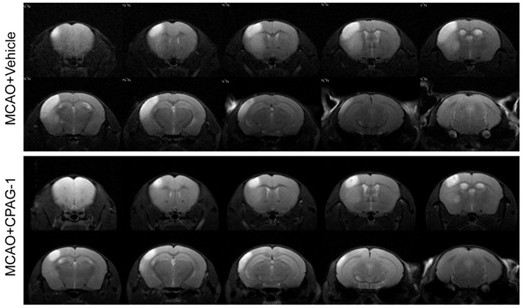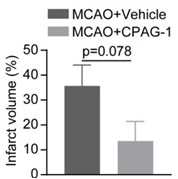Application of CPAG-1 in preparation of ischemic brain injury neuroprotective agent medicine
A technology of ischemic brain injury and CPAG-1, applied in drug delivery, drug combination, medical formula, etc., can solve the problems of inability to receive effective treatment, short time window, lack of treatment, etc., to reduce the volume of cerebral infarction, Reduces neurological deficits and promotes recovery
- Summary
- Abstract
- Description
- Claims
- Application Information
AI Technical Summary
Problems solved by technology
Method used
Image
Examples
Embodiment 1
[0017] Example 1: Statistical effects of CPAG-1 on cerebral infarction volume and cerebral edema.
[0018] The mice in the treatment group (MCAO+CPAG-1) and the control group (MCAO+Vehicle) were scanned by magnetic resonance T2-weighted images after 72 hours of treatment, respectively. The scan results are as follows: figure 1 As shown in the figure, ImageJ was used to calculate the brain dead volume and brain edema size of the MRI T2-weighted image scanning results of the two groups of mice. The statistical results are as follows: figure 2 , image 3 As shown, from the graphical results, the treatment group (MCAO+CPAG-1) can significantly reduce the volume of cerebral infarction and cerebral edema compared with the control group (MCAO+Vehicle).
Embodiment 2
[0019] Example 2: Neurological assessment of mice.
[0020] The mice in the treatment group (MCAO+CPAG-1) and the control group (MCAO+Vehicle) were evaluated for neurological function after 72 hours of treatment, respectively. Right forelimb cannot be fully extended); 2 is moderate neurological deficit (right rotation when walking forward); 3 is severe neurological deficit (body tilts to the right); 4 is very severe neurological deficit (inability to walk spontaneously) , confusion). The evaluation results are as Figure 4 As shown, from the graphical results, the treatment group (MCAO+CPAG-1) can significantly reduce the neurological damage after infarction compared with the control group (MCAO+Vehicle).
Embodiment 3
[0021] Example 3: Evaluation of motor and sensory functions in mice.
PUM
 Login to View More
Login to View More Abstract
Description
Claims
Application Information
 Login to View More
Login to View More - R&D
- Intellectual Property
- Life Sciences
- Materials
- Tech Scout
- Unparalleled Data Quality
- Higher Quality Content
- 60% Fewer Hallucinations
Browse by: Latest US Patents, China's latest patents, Technical Efficacy Thesaurus, Application Domain, Technology Topic, Popular Technical Reports.
© 2025 PatSnap. All rights reserved.Legal|Privacy policy|Modern Slavery Act Transparency Statement|Sitemap|About US| Contact US: help@patsnap.com



